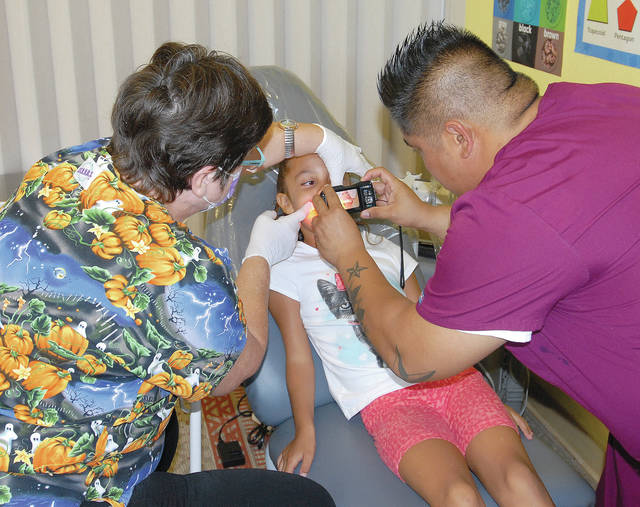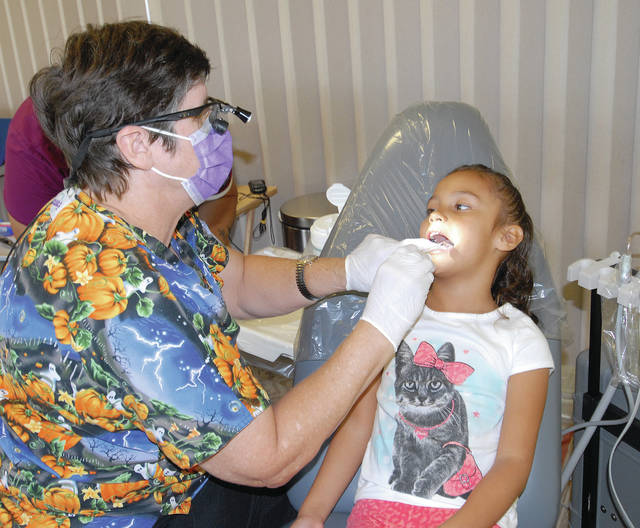KAILUA-KONA — For a kid, a toothache isn’t just a pain, it can also mean missed class time. But it’s not always easy for families to make it to a clinic or schedule an appointment without a car or a flexible schedule.
Over the past two years, the West Hawaii Community Health Center, with support from the Hawaii Dental Service Foundation and others, has seen 364 individual patients through its tele-dentistry pilot project. The project is a novel approach to providing oral health care and education to those who might otherwise go unserved, by getting professionals out to where the kids — and their teeth — are.
“When the hygienist is able to see them out at the preschool, those children are used to being there every day and they’re more comfortable there,” said John A. Gawlik, dental director and pediatric dentist at West Hawaii Community Health Center. “So they’re more cooperative for her then and it just makes a better environment, especially for the oral health education – the prevention.”
Now the pilot program is being expanded to Maui, the governor’s office announced Thursday, with funding support from the HDS Foundation and Hawaii Medical Service Association (HMSA) Foundation.
The HDS Foundation contributed about $315,000 in the first two years of the West Hawaii pilot program and is giving an additional $319,000 to continue the program into year three, according to a statement from the governor’s office.
Mark H. Yamakawa, president and chief executive officer of Hawaii Dental Service, presented a check on Wednesday to the West Hawaii Community Health Center for year three of the project.
The tele-dentistry program equips a hygienist and assistant with portable dental equipment, allowing them to go out into the community and provide oral exams, which include pictures and X-rays as well as oral health counseling, thereby preventing problems for kids and their parents.
A dentist can then look at the kids’ records and determine whether he or she needs to come to a clinic for treatment.
The West Hawaii program sends its team to a variety of settings where kids and their parents already are, such as Head Start programs at three locations and the Women, Infants and Children program office in Kealakekua.
In October a team of professionals checked teeth at Ulu Wini, an affordable rental and transitional housing complex in Kailua-Kona. There, the team saw a total of 23 kids over the two days they were there.
Paul Glassman, professor and director of community oral health at the University of the Pacific Arthur A. Dugoni School of Dentistry in San Francisco, said after the program was developed and tested in California, the school started conversations with the Hawaii Department of Health about seven or eight years ago in regards to replicating it here.
“There’s certainly lots of need, if not extraordinary amounts of need, here in Hawaii,” he said.
Parents can often face several barriers to care when it comes to getting their kids to a dentist, such as a lack of transportation or a work schedule that restricts their ability to arrange appointments. But programs like this can help overcome some of those hurdles.
“Bringing the dental services to where the children are to begin with addresses a lot of the barriers,” said Andrew W.L. Tseu, chief of the Department of Health’s Hospital and Community Dental Services branch.
And the people behind the effort say they hope it only grows from here.
That includes Gawlik, who said while they currently mostly see infants and preschoolers, the program could be expanded to elementary schools through high schools and beyond.
“You could expand it into senior living centers where there’s elderly that don’t have access to care because it’s difficult for them to leave the facility,” he added, saying they recently got a call from a facility inquiring about a dentist coming to do exams for residents.
And while they can’t, at the moment, afford to send a dentist to those sites and there are other hurdles to overcome, he believes there’s “a real future” for tele-dentistry in those situations. In fact, he said, tele-dentistry is the future, estimating that in 20 years, it’ll be an integral part of dental care.
“There’ll be lots of people using tele-health connected teams to reach populations that are not currently getting dental care,” he said.




